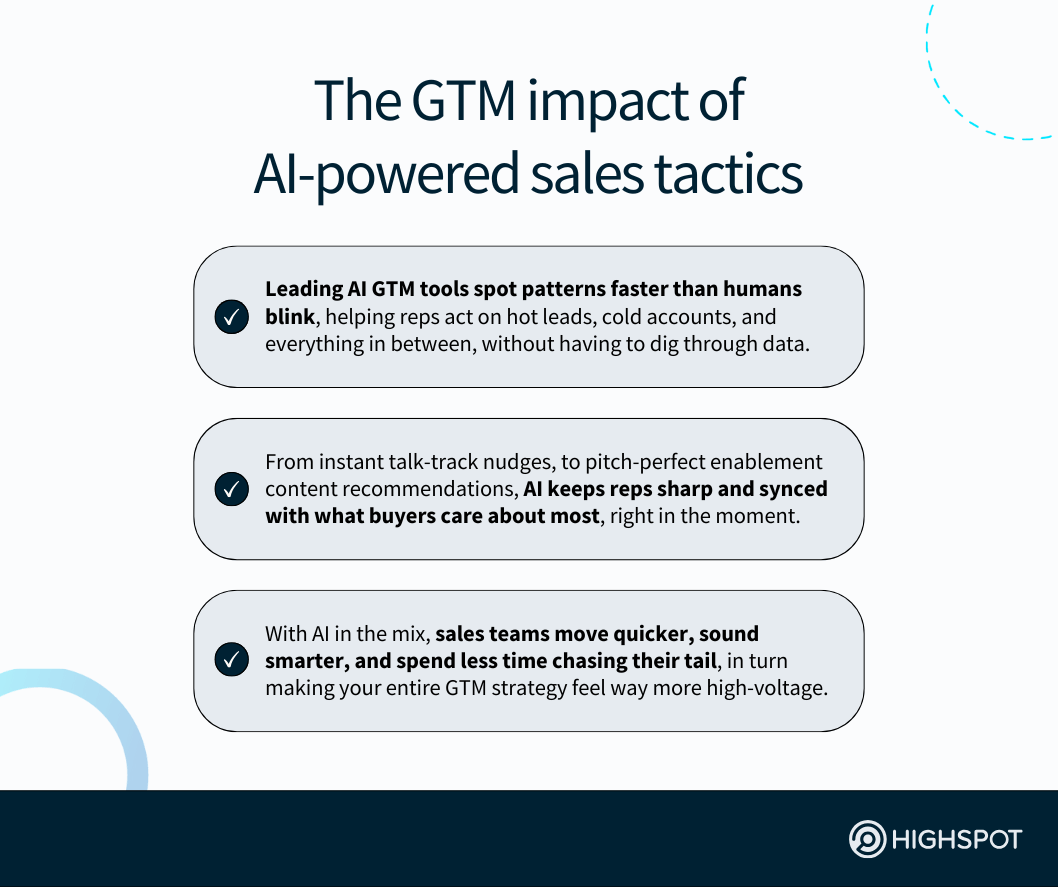Key Takeaways
- Your sales tactics and techniques only work when all your sales professionals are enabled with the right processes, tools, and guidance they need so every sales activity and conversation feels intentional.
- Technology and AI aren’t replacing sellers. They’re empowering them to connect earlier, personalise more, and execute consistently. Smart, timely execution is what separates top-performing sales teams.
- Trust is built in the details leading up to the deal. From the discovery call, to post-sale follow-up, communication and follow-through are the tactics that create the relationships that drive long-term revenue.
Today’s sales reps juggle endless tools, tabs, and touchpoints in an often futile effort to keep up with buyers who may already have all the information they need:
- These smart B2B shoppers research independently, compare vendors, and revisit choices several times before they even talk with your sales team.
- They loop between online research, internal discussions, and change direction as new stakeholders within their organisations weigh in with their preferred options.
- By the time you join the conversation, the lead may already have strong opinions (and, unfortunately, even misconceptions) about your products and services.
Your goal is to avoid repeating the details about your business and offerings a lead already has. It’s like mind-reading. You must anticipate what they know so you can clarify, challenge, and provide fresh value that helps them see their problem (and your solution) in a new way.
Per Forrester analysts, though, “In an effort to focus on active buyers, many B2B organisations over-rotate toward marketing tactics that engage buyers long after they have formed preferences.” This does more harm than good for your company.
That gap between buyer knowledge and expectations and seller execution is where most deals are lost—and, from the perspective of RevOps, where revenue is lost.
To bridge this go-to-market performance gap, your sales leaders must shift BDRs away from showing up late with one-size-fits-all tactics and toward more effective sales techniques that start earlier, are personalised to each buyer, and add real value for leads.

Why modern sales teams must evolve their selling tactics
The way that many buyers make decisions has changed faster than most sales teams can adapt. The linear B2B buying journey is gone, buyers have shorter attention spans with constant context switching, and data flows faster than ever.
Reps who rely on pre-defined scripts or antiquated tools lose deals to competitors who are better at active listening and use tech that empowers them to sell smarter.
Simply put, your BDRs must evolve their day-to-day sales techniques to match how your prospects actually purchase from organisations like yours today.
Buyer expectations have evolved beyond traditional sales playbooks
Buyers don’t want rehearsed demos packed with canned company decks with founding dates, office maps, or awards that they either already know or don’t care about. These are details that impress internal executives but do nothing to solve the customer’s problem.
Most leads research long before speaking with you, so repeating basic facts adds no value.
Sometimes the most formidable competitor isn’t another vendor—it’s Google or ChatGPT.
Sales reps who can’t go beyond the basic, already available info offered on their website and other online sources risk being replaced by search and answer engines.
To stand out, move beyond the instinct to start selling directly using a standard process and take a consultative selling approach that starts with a question: What business challenge are you trying to solve? This curiosity may uncover real context and kick off a discussion that helps you tailor solutions to tangible goals.
Data and AI are redefining how you build customer relationships
Every interaction with potential customers now leaves a digital trail from buyer engagement with sales materials to signals that reveal when deals are at risk.
Cutting-edge AI and analytics solutions can help sales professionals like you spot any relevant patterns early, turning raw data into guidance that informs next steps.
Go-to-market teams that regularly use AI for sales can better anticipate prospect concerns, adjust GTM messaging quickly, and spend more time engaging in meaningful conversations rather than manual research and documentation.
Sellers are better equipped to guide both potential customers and existing customers through the sales pipeline. As Bain & Company recently wrote, “When done right, leaders (deploying AI) can dramatically improve life for frontline sellers and build a durable edge over competitors still stuck in wait-and-see mode.”
That advantage only scales when supported by the proper infrastructure.
“What some still call ‘enablement’ has evolved,” per Highspot’s GTM Performance Gap Report. “In high-performing teams, it’s not a department; it’s the infrastructure through which strategy becomes execution. Execution, not access, is what separates the best.”
Together, these perspectives show how data, AI, and enablement come together to make sellers smarter. The best sales teams no longer treat enablement as a repository of content but rather as the connective tissue in their tech stack that turns insight into urgent action.
Sales cycle complexity demands cross-functional collaboration
Today’s B2B buyers jump between research, evaluation, and decision-making as new stakeholders join in on the purchase process and priorities change.
One enterprise deal might include a half-dozen or more departments reviewing proposals, contracts, and proof-of-concept environments at different times.
This complexity makes sales and marketing alignment and partnership critical.
Sales teams succeed when reps, marketing, enablement, and customer success all work from the same sales and marketing plan and playbook, where they share visibility into content engagement, objections, conversations, and timelines.
When everyone works from the same data set and context, buyers have a better experience, sales cycles shorten, win rates rise, and relationships strengthen.
Ongoing change requires continuous learning and adaptability
Successful sales strategies that worked last quarter may not work today. New technology, shifting markets, information availability, and evolving buyer behaviour raise the bar.
The most successful B2B sellers now rely on AI-powered solutions that provides valuable insights to learn and adjust to different sales tactics faster than competitors.
A sales training strategy that reinforces this agility helps every rep stay ready for what comes next. Just-in-time coaching and analytics that track what’s working can highlight how minor adjustments in tactics can significantly improve sales target gains.
| Sales tactic example | How it helps sales leaders and reps |
| Practice objection handling with AI tools | Simulating objection scenarios with AI builds muscle memory and sharpens response skills for high-stakes deals. |
| Automate the creation of pitch materials | Auto-generate assets with buyer data to personalise messaging and save reps time, especially during fast-moving deals. |
| Embed rep guidance into CRM workflows | Surfacing guidance in CRM tools ensures reps follow strategy without leaving their daily workflow, increasing adoption. |
| Reinforce training with rep assessments | Quick quizzes after training sessions help reps retain key messages and learnings without taking them out of the field. |
| Centralise deal content in shared portals | Consolidate deal docs and updates in one place, giving buyers an organised space to engage and make decisions faster. |
| Measure initiative impact with scorecards | Scorecards help connect GTM activities to revenue outcomes, making it easy to adjust tactics and double down on wins. |
| Use AI to retrieve answers in meetings | Leading GTM AI tools pull relevant info during calls, helping reps answer questions with confidence and precision. |
| Analyse buyer signals from call recordings | Review call transcripts to identify buyer interest, objections, and gaps and drive more targeted follow-up and coaching. |
10 effective sales tactics that work for B2B sellers today
Evolving how your sales team sells starts with better understanding your target buyers, but the most significant improvements come from what you do next.
Successful salespeople build trust by aligning every conversation with the buyer’s goals and showing a genuine interest in solving problems, not just closing deals.
Below are the best sales tactics used by many B2B companies that can improve your sales process, help reps build more impactful and trustworthy relationships with leads, and increase revenue generated from both new customers and current customers.
1. Practice active listening to uncover buyer needs
Too many salespeople rush discovery calls, focusing on the latest and greatest features instead of the prospect’s business needs. Active listening flips the script.
Ask thoughtful, consultative selling questions and repeat back what you hear to show that you understand. Use notes from your sales process, prior engagements, industry knowledge, and customer data to uncover the most significant pain points.
This simple habit turns surface conversations into meaningful sales opportunities.
- Sales tactic best practice: Reps who zip their lips and tune in tight hear what potential customers actually need—gold you can’t dig up by talking over them.
2. Use value selling instead of high-pressure tactics
High-pressure sales tactics may deliver a quick sale in niche industries, such as used cars, but they rarely build the lasting relationships necessary for enterprise sales and repeat business.
Buyers know when you’re focused more on closing the deal than actually helping them.
The best sales strategies and tactics are reciprocal. They create real, measurable value. Sellers get their commission. Buyers get a product that addresses a need.
Focus on the impact of your product or service, such as cost savings, productivity gains, or risk reduction, and connect the results to the target market’s goals.
Using the value-based sales methodology can help each of your sales reps earn trust without crossing into aggressive selling or unethical selling behaviour.
- Sales tactic best practice: Value-based selling turns “meh” interest into real momentum. Helping your prospects ‘win’ beats pressuring them into buying regret.
3. Strengthen your pitch with AI-guided role play
It goes without saying that artificial intelligence is a game-changer, when it comes to learning and guidance. Coaching tools with AI can actively listen to sales calls, analyse tone and pacing, and share feedback about what resonates with buyers.
The increasing use of artificial intelligence in sales even highlights which phrases, narratives, or consultative questions drive the most engagement. For reps, in particular, it’s like having a personal coach that never has a bad day or gets tired.
Reps are more confident in their communication when they have thoroughly researched (by AI) facts, deliver stronger messaging, and engage in natural sales conversations because they’re supported by data and practice, not pre-defined scripts.
This is an advantage that helps them close deals with their target audience.
- Sales tactic best practice: Treat sales role play like dress rehearsal for Broadway: Mess up in private, and hit every note when it’s ‘curtain time’ for deal discussions.
4. Pay close attention to body language and tone
A strong sales pitch can fall flat if your delivery doesn’t match your message.
Eye contact, positive attitude, body language, gestures, and pacing can influence how buyers respond. This also matters on virtual calls, where posture and presence signal confidence.
It’s the reps who mirror their buyer’s tone and recognise their sense of urgency who find their conversations flow better, enhancing the odds that they’re able to organically establish long-term relationships with those stakeholders.
- Sales tactic best practice: Your lead’s eyebrows are talking, and their posture’s got opinions. Learn how to decode both or risk missing critical buying signals.
5. Personalise messages using your customer data
The average B2B buyer can spot generic outreach a mile away.
Do more than insert a lead’s name atop email. Use your customer relationship management data, purchase history, and content engagement to tailor messages, calls, and demos.
Reference something current that you discover, such as a product launch, a hiring or promotion announcement, or a common challenge in their industry. When you connect the dots between their reality and your product or service, you prove that you genuinely care.
- Sales tactic best practice: Using engagement and deal intel to tailor your pitch is how you make each buyer feel like a VIP and wonder where you’ve been all their life.
6. Involve account executives in high-pressure deals
Big opportunities often stall when cross-team communication falls apart or the right experts join too late. Looping in the right people early, whether that’s the account executive, technical resource, sales operations, or another C-level executive, keeps momentum going.
Bring in team members to answer complicated questions, address technical or financial concerns. When sales reps coordinate the right mix of voices at the right stage, buyers see a unified team ready to solve their problem.
- Sales tactic best practice: When the heat’s on, tag in your AE for assistance. They’re the sales version of a seasoned sous-chef, slicing objections and plating up options.
7. Share sales materials that address pain points
Prospective customers want solutions, not sales jargon or feature tours.
Supply your sales team with relevant case studies, product comparisons, ROI summaries, and competitive assets that match a buying group’s questions, industry, and funnel stage.
- Sales tactic best practice: Generic pitch decks are forgettable. Give leads sharp, pain-point-crushing content that feels handcrafted so they know you truly care.
8. Build digital sales rooms to centralise deal assets
Enterprise deals often have large buying committees, including finance, IT, operations, and procurement. They all review different materials in their own time. Too many salespeople try to manage this with email threads that are impossible to follow and scattered attachments.
A digital sales room (DSR) addresses this by consolidating all sales materials, product demos, sell sheets, contracts, and proposals in a single, easy-to-access hub.
This approach accelerates collaboration, minimises confusion, and keeps all stakeholders aligned throughout conversations from awareness to the initial sale and final signature.
- Sales tactic best practice: A clean digital space beats inbox chaos. No more “Where’s that doc?” drama, just everything your buyer needs when and where they want it.
9. Use AI tools to deliver just-in-time guidance
In fast-moving deals, timing is everything.
Having a leading GTM enablement tool in your sales tech stack allows rep deliver real-time nudges that keep reps aligned with the sales process and aware of buyer behaviour.
For example, when a target company revisits your pricing page, a quick alert might trigger a perfectly timed follow-up call or pricing page recommendation.
These small prompts prevent missed opportunities and keep deals moving forward, allowing you to increase sales and maintain a healthy sales pipeline.
- Sales tactic best practice: Don’t let your sales reps wing it. Serve them the right tip, template, or talk track when they need it so they can keep prospects fully engaged.
10. Review and refine tactics with sales analytics
The right sales tactics evolve through reflection and, after analysis, refinement Data shows which sales messages land, which opportunities convert, sales techniques to avoid, cross-selling and expansion opportunities, and where deals get stuck.
Review deals that were won and lost to identify coaching moments. Analyse trends by buyer persona, industry, or deal size to see what really drives results.
- Sales tactic best practice: Your go-to-market data enables you to ditch your hunches, remix sales plays, and show up with a solid relationship-building approach that sticks.
Build trust that drives long-term sales and GTM success
Not every tactic that closes deals today builds sales success tomorrow.
The objective measure of an effective sales plan today isn’t just the revenue it generates for your business. It’s also the trust it builds with your customers, consistency of use, and relationships developed by your sellers that ultimately lead to repeat business and renewals.
Avoid the endless fads and traps that slow teams down: high-pressure tactics, overselling the latest minor product features, or chasing a quick sale without discovering the buyer’s goals.
Those moves might grab attention, but they don’t earn customers’ loyalty in the long run.
The sales reps (and AEs) who win today are the ones who make it comfortable for buyers to engage and learn more. They use customised outreach and consistent follow-through to earn trust, attract more potential customers, and build partnerships that last.
What’s more, they use best-in-class, AI-powered GTM solutions with robust sales analytics and automation capabilities to make reps’ lives easier and enable them to move faster, show up smarter, and win more deals with greater consistency.




